The Legume Family
With close to 800 genera and over 23,000 species, the Leguminosae is the third largest angiosperm family in terms of species numbers after Asteraceae and Orchidaceae. Legumes are economically important food crops providing highly nutritious sources of protein and micronutrients that can greatly benefit health and livelihoods. They have been domesticated alongside grasses in different areas of the world since the beginnings of agriculture and have played a key role in its early development. Legumes are also uniquely important as fodder and green manure in both temperate and tropical regions, and are used for their wood, tannins, oils and resins, in the manufacture of varnishes, paints, dyes and medicines, and in the horticultural trade. The family is morphologically, physiologically and ecologically exceptionally diverse. It is one of the most spectacular examples of evolutionary diversification in plants.
Legumes are cosmopolitan in distribution, representing important ecological constituents in almost all biomes across the globe and occur in even the most extreme habitats. They constitute significant elements in terms of both species diversity and abundance in lowland wet tropical forests especially in the Neotropics. They also dominate dry forests and savannas throughout the tropics, and are also very diverse and abundant in Mediterranean and other temperate regions, up to high latitudes and at high elevations. They can be large emergent tropical trees with buttresses, small ephemeral annual herbs, climbing annuals or perennials with tendrils, desert shrubs, geoxylic subshrubs, woody lianas and, less commonly, aquatics. Flower symmetry spans the full range from radially symmetric (actinomorphic) to bilaterally symmetric (zygomorphic) and asymmetric flowers, which are in turn adapted to a wide range of pollinators such as insects, birds and bats. The ability of the majority of legume species to fix atmospheric nitrogen in symbiosis with soil rhizobia is perhaps the best known ecological characteristic of the family; however, not all legumes form associations with nitrogen-fixing bacteria.
Two questions are frequently asked about the legume family: what is the correct name for the family and should it be recognised as a single family. The plant family Leguminosae or Fabaceae is a monophyletic group that must be treated as a single family and can be recognised under either name. Dividing the group into three separate families (Caesalpiniaceae, Mimosaceae, Papilionaceae or Fabaceae), as has sometimes been the practice in the past, is untenable. In 2017, the Legume Phylogeny Working Group (LPWG 2017) revised the higher level classification and recognised six monophyletic subfamilies. Under the LPWG classification, subfamily Caesalpinioideae was re-circumscribed as a clade that includes the nested mimosoid clade; and Cercidoideae, Detarioideae, Dialioideae and Duparquetioideae (all of which were previously part of Caesalpinioideae) were recognised as distinct subfamilies along with Papilionoideae.
Legume Phylogeny Working Group
The Legume Phylogeny Working Group, LPWG, was established in 2010 as an informal global consortium of legume systematists to foster collaborative research in legume systematics, building on several decades of data sharing and collaboration since the first International Legume Conference organised by Roger Polhill and colleagues in 1978. While the name LPWG implies a specific focus on phylogenetics, in practice the LPWG spans a broader range of activities across legume systematics and evolution as a whole. LPWG activities have resulted in a series of collaborative papers published under the LPWG umbrella:
- An overview paper in 2013 LPWG. 2013. Legume phylogeny and classification in the 21st century: Progress, prospects and lessons for other species–rich clades. Taxon 62: 217-248.
- A major community-endorsed phylogenetically-based subfamily classification of the legume family in 2017 LPWG. 2017. A new subfamily classification of the Leguminosae based on a taxonomically comprehensive phylogeny. Taxon 66: 44-77.
- A paper outlining a blueprint for a new legume species information system Bruneau et al. (LPWG). 2019. Towards a new online species-information system for legumes. Australian Systematic Botany 32: 495-518.
The LPWG has established five working groups focused on Taxonomy, Phylogenomics, Occurrence Data, Functional Trait Data and Tree of Life with a view to further stimulating and coordinating large-scale collaborative family-wide data assembly and analyses. These working groups are open to wider participation by all! If you want to get involved in a specific working group, please contact the individual working group coordinators by visiting the relevant Working Group’s page.
